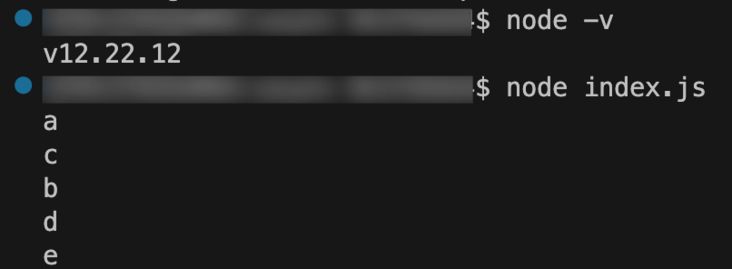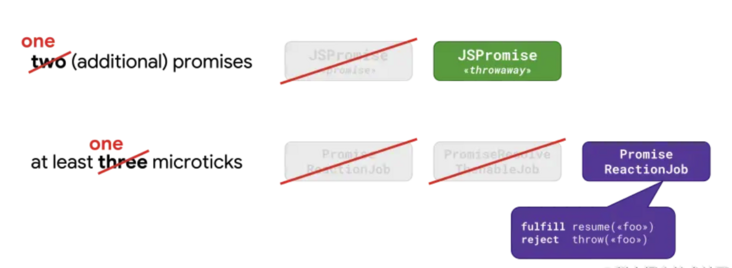「过程详解」async await综合题
wuwhswuwhs -前言
如果你之前跟我一样一直对asyncawait熟悉又陌生的话(熟悉是可能每天都在用,陌生是针对一些组合题又丈二和尚摸不着头脑),不妨可以边看边练,总结规律,相信会逐渐清晰并有所得。本文对每个案例都详细描述了代码的执行流程,如有不妥欢迎指正。
async函数默认会返回一个Promise对象,不管最后函数有没有return值。但是针对具体的返回值情况,实际上表现会有所不同,下面分别看看。
这里的普通值是指基础类型值(Number、String和Boolean等)和非thenable和非Promise的值
async function foo() {
return 'foo'
}
foo().then(() => console.log('a'))
Promise.resolve()
.then(() => console.log('b'))
.then(() => console.log('c'))
// 输出结果:a b c很简单,不出意外输出a b c,也就是async函数在执行完成后是没有等待的。
foo()执行完成没有等待,遇到then将console.log('a')放入微任务队列;继续往下执行Promise.resolve(),遇到then将console.log('b')入队,当前同步任务全部执行完成;开始执行微任务队列,首先取出并执行console.log('a')输出a;然后取出并执行console.log('b')输出b,此时遇到then将console.log('c')入队;最后取出并执行console.log('c')输出c,至此微任务队列清空,代码执行结束;
所谓值为thenable是指定义了then方法的对象,可以是一个字面对象,也可以是一个Class实例。
class Bar {
then(resolve) {
resolve()
console.log('then')
}
}
async function foo() {
// return new Bar()
return {
then(resolve, reject) {
resolve()
console.log('then')
}
}
}
foo().then(() => console.log('a'))
Promise.resolve()
.then(() => console.log('b'))
.then(() => console.log('c'))
// 输出结果:then b a c怎么顺序不一样了呢?
如果async函数的返回值是一个thenable,等同于生成一个Promise,在foo函数执行完成,并且Promise状态变更(resolve或者reject)后,还要等1个then的时长foo()返回thenable值,执行then方法,Promise状态变更,执行console.log('then')输出then,等待1个then时长;继续往下执行Promise.resolve(),遇到then将console.log('b')放入微任务队列,当前同步任务执行完成;开始执行微任务队列,首先取出并执行console.log('b')输出b,当前微任务队列清空;此时步骤1等待时长到期,遇到then将console.log('a')放入队列,取出执行输出a;继续步骤3遇到then将console.log('c')放入队列,取出执行输出c,至此微任务队列清空,代码执行结束;这里如果foo函数返回的thenable方法的状态没有变更,则后面的foo().then将永远不会执行。
async function foo() {
return {
then(resolve, reject) {
console.log('then')
}
}
}
foo().then(() => console.log('a'))
Promise.resolve()
.then(() => console.log('b'))
.then(() => console.log('c'))
// 输出结果:then b creturn后面的值是Promise,比如 new Promise(resolve=>resolve())和Promise.resolve。
async function foo() {
return Promise.resolve('foo')
}
foo().then(() => console.log('a'))
Promise.resolve()
.then(() => console.log('b'))
.then(() => console.log('c'))
.then(() => console.log('d'))
// 输出结果:b c a d明显可以看出async函数执行完后延迟了2个then时长。
foo()返回Promise值,Promise状态变更,等待2个then时长;继续往下执行Promise.resolve(),遇到then将console.log('b')放入微任务队列,当前同步任务执行完成;开始执行微任务队列,首先取出并执行console.log('b')输出b,当前微任务队列清空;遇到then将console.log('c')放入队列,取出执行输出c;此时步骤1等待时长到期,遇到then将console.log('a')放入队列,取出执行输出a;继续步骤4遇到then将console.log('d')放入队列,取出执行输出d,至此微任务队列清空,代码执行结束;综合上述表现可以总结出如下规律
既然async函数返回值对代码执行顺序有影响,那么await后面的表达式值是否也有影响呢?下面同样分为上述三种场景进行实验分析
async function foo() {
await 'foo'
console.log('a')
}
foo().then(() => console.log('b'))
Promise.resolve()
.then(() => console.log('c'))
.then(() => console.log('d'))
// 输出结果:a c b d可以判断,await后面的表达式值如果是普通值,无须等待then时长。那么,为什么b会在c后面输出呢?
await表达式有执行结果后,await下一行到函数结束部分代码codex可以看做放置到微任务队列中,等同于Promise.resolve(await xxx).then(()=>codex),这里是伪代码,await在时间顺序上等效于Promise.prototype.then。await 'foo'执行完成后,console.log('a')被添加到微任务队列;继续往下执行同步任务Promise.resolve(),遇到then将console.log(c)添加到微任务队列,当前同步任务执行完成;然后执行微任务队列中任务,取出并执行console.log('a')输出a;此时foo函数执行完成,遇到then将console.log('b')入队;继续执行微任务队列中console.log('c')输出c,此时遇到then将console.log('d')入队;最后依次执行取出剩余微任务,执行并输出b和d,至此微任务队列清空,代码执行结束;
async function foo() {
await {
then(resolve) {
resolve()
console.log('then')
}
}
console.log('a')
}
foo().then(() => console.log('b'))
Promise.resolve()
.then(() => console.log('c'))
.then(() => console.log('d'))
.then(() => console.log('e'))
// 输出结果 then c a d b eawait后面表达式值如果是thenable,需要等待1个then时长,才会去执行后续代码。
foo()执行await是一个thenable,Promise状态变更,执行同步代码console.log('then'),输出then,此时等待1个then时长;继续往下执行同步任务Promise.resolve(),遇到then将console.log('c')加入到微任务队列,当前同步任务执行完成;开始执行微任务队列,取出并执行console.log('c'),输出c,微任务队列清空;此时步骤1等待时长到期,将await后续代码console.log('a')入队;继续步骤3,遇到then将console.log('d')入队,然后依次取出console.log('a')和console.log('d')并执行,输出a和d;执行完console.log('d')遇到then将console.log('e')放入队列,取出执行,输出e;确实有点绕,我们将1个then等待时长看做是下一个微任务从入队到执行完成出队的时间就好。比如这里c任务执行完成,下一个任务d正准备进入被a插了队。
async function foo() {
await Promise.resolve('foo')
console.log('a')
}
foo().then(() => console.log('b'))
Promise.resolve()
.then(() => console.log('c'))
.then(() => console.log('d'))
.then(() => console.log('e'))
// 输出结果 a c b d eawait后面表达式如果是Promise,和普通值的结果是一样,无须等待then时长。
为什么不和return为Promise的情景一样是2次呢?原来这是nodejs在后期版本优化后的结果:移除了2个微任务,1个throwaway promise,具体原因可以查看「译」更快的 async 函数和 promises。
。
对于早期版本(node 11及以前),输出的结果是c d a e b,需要等待2个then等待时长。
foo()执行await是一个Promise,Promise状态变更,此时等待2个then时长;继续往下执行同步任务Promise.resolve(),遇到then将console.log('c')加入到微任务队列,当前同步任务执行完成;开始执行微任务队列,取出并执行console.log('c'),输出c,微任务队列清空;遇到then将console.log('d')入队,去除并执行,输出d,微任务队列清空;此时步骤1等待时长到期,将await后续代码console.log('a')入队;继续步骤4,遇到then将console.log('e')入队,然后依次取出console.log('a')和console.log('e')并执行,输出a和e;执行完console.log('a')遇到then将console.log('b')放入队列,取出执行,输出b;综合await表达式值的结果,我们可以总结
以上我们仅仅从async的return值和await表达式值单一视角来看,下面综合他们两个来分析(统一在node 12+环境)。
首先,await是一个普通函数(非async函数)
function baz() {
// console.log('baz')
// return 'baz'
// return {
// then(resolve) {
// console.log('baz')
// resolve()
// }
// }
return new Promise((resolve) => {
console.log('baz')
resolve()
})
}
async function foo() {
await baz()
console.log('a')
}
foo().then(() => console.log('b'))
Promise.resolve()
.then(() => console.log('c'))
.then(() => console.log('d'))
.then(() => console.log('e'))
// await baz函数return是普通值 输出结果是baz a c b d e
// await baz函数return是thenable 输出结果是 baz c a d b e
// await baz函数return是Promise 输出结果 baz a c b d e与直接await表达式值输出一致。
return是普通值,不等待then时长;baz函数return是thenable,等待1个then时长;baz函数return是Promise,不等待then时长;
然后将baz函数改成async
async function baz() {
// console.log('baz')
// return 'baz'
// return {
// then(resolve) {
// console.log('baz')
// resolve()
// }
// }
return new Promise((resolve) => {
console.log('baz')
resolve()
})
}
async function foo() {
await baz()
console.log('a')
}
foo().then(() => console.log('b'))
Promise.resolve()
.then(() => console.log('c'))
.then(() => console.log('d'))
.then(() => console.log('e'))
// await baz函数return是普通值 输出结果是baz a c b d e
// await baz函数return是thenable 输出结果是 baz c a d b e
// await baz函数return是Promise 输出结果 baz c d a e b
// node12 以下版本 await baz函数return是Promise 输出结果 baz c d e a b从中我们可以发现:awaitasync函数的等待时长与async baz函数的return值等待时长保持一致。
return是普通值,不等待then时长;async baz函数return是thenable,等待1个then时长;async baz函数return是Promise,等待2个then时长,但是在node12以下版本会等待3个then时长;
下面我们综合async、await、Promise、then和setTimeout来看一道题目
const async1 = async () => {
console.log('async1')
setTimeout(() => {
console.log('timer1')
}, 2000)
await new Promise((resolve) => {
console.log('promise1')
resolve()
})
console.log('async1 end')
return Promise.resolve('async1 success')
}
console.log('script start')
async1().then((res) => console.log(res))
console.log('script end')
Promise.resolve(1)
.then(Promise.resolve(2))
.catch(3)
.then((res) => console.log(res))
setTimeout(() => {
console.log('timer2')
}, 1000)思考几分钟,输出结果
// script start
// async1
// promise1
// script end
// async1 end
// 1
// async1 success
// timer2
// timer1script start和async1,遇到setTimeout放入宏任务队列;继续往下执行await表达式,执行new Promise输出promise1,Promise状态变更,不等待then时长,将后续代码添加到微任务队列;继续往下执行输出script end,执行Promise.resolve(1)遇到then将Promise.resolve(2)放入微任务队列;再往下执行遇到setTimeout放入宏任务队列,至此同步任务执行完毕;开始执行微任务队列,取出并执行步骤2的后续代码输出async1 end,返回一个已变更的Promise对象,需要等待2个then时长;继续取出微任务Promise.resolve(2)并执行,状态为resolved后面走then;遇到then将(res) => console.log(res)放入微任务队列,然后取出并执行输出1,注意:then中是非函数表达式会执行,默认返回的是上一个Promise的值,then(Promise.resolve(2))会透传上一层的1;此时步骤5等待时长到期,将(res) => console.log(res)放入微任务队列,然后取出并执行输出async1 success;最后2个定时器分别到期,输出timer2和timer1;如果对这个案例再稍作改造
const async1 = async () => {
console.log('async1')
setTimeout(() => {
console.log('timer1')
}, 2000)
await new Promise((resolve) => {
console.log('promise1')
})
console.log('async1 end')
return 'async1 success'
}
console.log('script start')
async1().then((res) => console.log(res))
console.log('script end')
Promise.resolve(1)
.then(2)
.then(Promise.resolve(3))
.catch(4)
.then((res) => console.log(res))
setTimeout(() => {
console.log('timer2')
}, 1000)
// 输出结果:
// script start
// async1
// promise1
// script end
// 1
// timer2
// timer1具体过程就不一一列举了,从输出结果可以发现:如果await表达式的Promise的状态没有变更,以下代码以及后面的then永远都不会执行。then的执行时机是在前面函数执行完成并且Promise状态变更以后才会被添加到微任务队列中等待执行。
通过以上就是基本asyncawait的使用场景,以及综合then、Promise和setTimeout的混合使用,大致可以总结如下几条规律:
async函数的return值为thenable会等待1个then时长,值为Promise会等待2个时长;await表达式值为thenable会等待1个then时长,值为Promise在node12+不等待then时长,低版本node等待2个then时长;await一个async函数,async函数的return值为thenable会等待1个then时长,值为Promise在node12+会等待2个then时长,在低版本node等待3个then时长;如果then中是非函数,表达式本身会执行,默认返回的是上一个Promise的值,也就是透传上一个Promise结果;如果await表达式的Promise的状态没有变更,以下代码以及后面的then永远都不会执行;以上案例均通过实验运行得出,流程如有解释错误,欢迎指正,完~
Tags 标签
前端javascriptasync-awaitpromisenode.js扩展阅读
CSGO电竞API数据接口【West S2战队数据】分享使用演示
2020-09-03 07:18:05 []wamp配置局域网访问
2020-09-04 01:12:17 []接口测试工具apipost3.0版本对于流程测试和引用参数变量
2020-09-15 15:12:13 []vs code的使用与常用插件和技巧大全总结
2020-09-17 03:07:47 []没有伞的孩子 [必须] 要学会奔跑
2020-09-17 04:49:49 []学习之apipost3.0文档移动和文档管理教程
2020-09-18 06:19:35 []分享—如何使用apipost模拟手机实现请求发送
2020-09-18 12:15:00 []【分享】apipost如何使用mock测试
2020-09-19 21:59:25 []Apipost使用技巧之分享
2020-09-19 11:44:49 [][分享] 轻松快捷完成领导要求的word格式的接口文档,再也不用因为编写word格式的接口文档而烦恼
2020-09-27 17:35:44 []加个好友,技术交流

